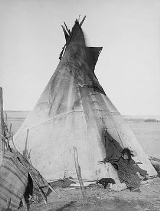
Tipi
Encyclopedia
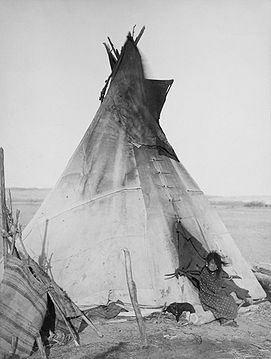
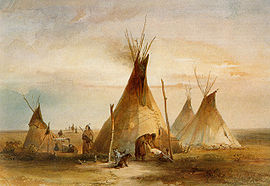
Tent
A tent is a shelter consisting of sheets of fabric or other material draped over or attached to a frame of poles or attached to a supporting rope. While smaller tents may be free-standing or attached to the ground, large tents are usually anchored using guy ropes tied to stakes or tent pegs...
traditionally made of animal skins and wooden poles used by the nomadic tribes and sedentary tribal dwellers (when hunting) of the Great Plains
Great Plains
The Great Plains are a broad expanse of flat land, much of it covered in prairie, steppe and grassland, which lies west of the Mississippi River and east of the Rocky Mountains in the United States and Canada. This area covers parts of the U.S...
. Tipis are stereotypically
Stereotype
A stereotype is a popular belief about specific social groups or types of individuals. The concepts of "stereotype" and "prejudice" are often confused with many other different meanings...
associated with Native Americans in general but Native Americans from places other than the Great Plains mostly used different types of dwelling
Dwelling
Dwelling, as well as being a term for a house, or for living somewhere, or for lingering somewhere, is a philosophical concept which was developed by Martin Heidegger. Dwelling is about making yourself at home where the home itself is a building that is a house...
s. The term "wigwam
Wigwam
A wigwam or wickiup is a domed room dwelling used by certain Native American tribes. The term wickiup is generally used to label these kinds of dwellings in American Southwest and West. Wigwam is usually applied to these structures in the American Northeast...
" (a domed structure) is sometimes incorrectly used to refer to a tipi.
The tipi was durable, provided warmth and comfort in winter, was dry during heavy rains, and was cool in the heat of summer. Tipis could be disassembled and packed away quickly when a tribe
Tribe
A tribe, viewed historically or developmentally, consists of a social group existing before the development of, or outside of, states.Many anthropologists use the term tribal society to refer to societies organized largely on the basis of kinship, especially corporate descent groups .Some theorists...
decided to move and could be reconstructed quickly when the tribe settled in a new area. This portability was important to Plains Indians
Plains Indians
The Plains Indians are the Indigenous peoples who live on the plains and rolling hills of the Great Plains of North America. Their colorful equestrian culture and resistance to White domination have made the Plains Indians an archetype in literature and art for American Indians everywhere.Plains...
with their nomad
Nomad
Nomadic people , commonly known as itinerants in modern-day contexts, are communities of people who move from one place to another, rather than settling permanently in one location. There are an estimated 30-40 million nomads in the world. Many cultures have traditionally been nomadic, but...
ic lifestyle.
Modern tipi covers are usually made of canvas
Canvas
Canvas is an extremely heavy-duty plain-woven fabric used for making sails, tents, marquees, backpacks, and other items for which sturdiness is required. It is also popularly used by artists as a painting surface, typically stretched across a wooden frame...
. Contemporary users of tipis include historical reenactors
Historical reenactment
Historical reenactment is an educational activity in which participants attempt torecreate some aspects of a historical event or period. This may be as narrow as a specific moment from a battle, such as the reenactment of Pickett's Charge at the Great Reunion of 1913, or as broad as an entire...
, back-to-the-land devotees, and Native American families attending powwow
PowWow
PowWow is a wireless sensor network mote developed by the Cairn team of IRISA/INRIA. The platform is currently based on IEEE 802.15.4 standard radio transceiver and on an MSP430 microprocessor...
s or encampments who wish to preserve and pass on a part of their heritage and tradition.
The word "tipi" comes into English from the Lakota language
Lakota language
Lakota is a Siouan language spoken by the Lakota people of the Sioux tribes. While generally taught and considered by speakers as a separate language, Lakota is mutually understandable with the other two languages , and is considered by most linguists one of the three major varieties of the Sioux...
; the word thípi ˈtʰipi consists of two elements: the verb thí, meaning "to dwell", and a plural
Plural
In linguistics, plurality or [a] plural is a concept of quantity representing a value of more-than-one. Typically applied to nouns, a plural word or marker is used to distinguish a value other than the default quantity of a noun, which is typically one...
ising enclitic
Clitic
In morphology and syntax, a clitic is a morpheme that is grammatically independent, but phonologically dependent on another word or phrase. It is pronounced like an affix, but works at the phrase level...
(a suffix-like ending that marks the subject of the verb as plural), pi, and means "they dwell". Lakota verbs can be used as nouns and this is the case with thípi, which in practice just means "dwelling".
Structure
A typical family tipi is a conical, portable structure with two adjustable smoke flaps, multiple poles ( historically from 12 to 25 feet long), and a detachable cover over the structure. The cover historically used buffaloAmerican Bison
The American bison , also commonly known as the American buffalo, is a North American species of bison that once roamed the grasslands of North America in massive herds...
skins; an optional skin/cloth lining; and a canvas or bison calf skin (historically) door. There may also be an optional, partial interior ceiling, called an ozan in Lakota, that covers sleepers and protects them from rain.
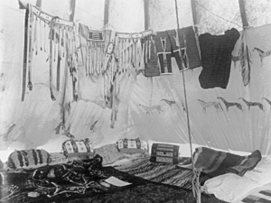
Travois
A travois is a frame used by indigenous peoples, notably the Plains Indians of North America, to drag loads over land...
on which additional poles and tipi cover were placed..
Tipi covers are made by sewing together strips of canvas or tanned bison hide (historically) and cutting out a semicircular
Semicircle
In mathematics , a semicircle is a two-dimensional geometric shape that forms half of a circle. Being half of a circle's 360°, the arc of a semicircle always measures 180° or a half turn...
shape from the resulting surface. Trimming this shape yields a door
Door
A door is a movable structure used to open and close off an entrance, typically consisting of a panel that swings on hinges or that slides or rotates inside of a space....
and the smoke flaps
Smoke flaps
- Smoke flap :Commercially a smoke flap can take the form of a metal, tin, or other alloy and can be manipulatable by hand or lever, and appears in home chimneys, stoves, or boilers...
that allow the dwellers to control the chimney
Chimney
A chimney is a structure for venting hot flue gases or smoke from a boiler, stove, furnace or fireplace to the outside atmosphere. Chimneys are typically vertical, or as near as possible to vertical, to ensure that the gases flow smoothly, drawing air into the combustion in what is known as the...
effect to expel smoke from their fires. Old style traditional linings were hides, blankets, and rectangular pieces of cloth hanging about four to five feet above the ground tied to the poles or a rope. Today's modern lining is the most difficult element to measure, since it consists of trapezoid
Isosceles trapezoid
In Euclidean geometry, an isosceles trapezoid is a convex quadrilateral with a line of symmetry bisecting one pair of opposite sides, making it automatically a trapezoid...
-shaped strips of canvas assembled to form the shape of a truncated cone. The poles, made of peeled, polished and dried tapering saplings (historically pine
Pine
Pines are trees in the genus Pinus ,in the family Pinaceae. They make up the monotypic subfamily Pinoideae. There are about 115 species of pine, although different authorities accept between 105 and 125 species.-Etymology:...
), are cut to measure about six feet more than the radius
Radius
In classical geometry, a radius of a circle or sphere is any line segment from its center to its perimeter. By extension, the radius of a circle or sphere is the length of any such segment, which is half the diameter. If the object does not have an obvious center, the term may refer to its...
of the cover. Historically the family tipi bison skin covers were richly painted and drawn upon, mostly with images of deeds of the owner or owners and of sacred religious symbols, as evidenced in historical accounts (from the 16th century until 19th century), Plains warriors' Ledger art
Ledger Art
Ledger Art is a term for Plains Indian narrative drawing or painting on paper or cloth. Ledger art was primarily from the 1860s to about 1900, although some of the old style drawing continues to the 1930s. There is also a contemporary group of accomplished Native American artists who work in the...
paintings from the 19th century, and anthropological studies.
Decoration
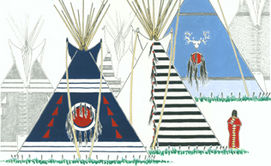
Vision quest
A vision quest is a rite of passage in some Native American cultures.In many Native American groups, the vision quest is a turning point in life taken before puberty to find oneself and the intended spiritual and life direction. When an older child is ready, he or she will go on a personal,...
, "ceremonies and prayers were first offered, and then the dreamer recounted his dream to the priests and wise men of the community... Those known to be skilled painters were consulted, and the new design was made to fit anonymously within the traditional framework of the tribe's painted tipis."
Many tipis, including those the Cheyenne
Cheyenne
Cheyenne are a Native American people of the Great Plains, who are of the Algonquian language family. The Cheyenne Nation is composed of two united tribes, the Só'taeo'o and the Tsétsêhéstâhese .The Cheyenne are thought to have branched off other tribes of Algonquian stock inhabiting lands...
, Sioux
Sioux
The Sioux are Native American and First Nations people in North America. The term can refer to any ethnic group within the Great Sioux Nation or any of the nation's many language dialects...
, Arapaho
Arapaho
The Arapaho are a tribe of Native Americans historically living on the eastern plains of Colorado and Wyoming. They were close allies of the Cheyenne tribe and loosely aligned with the Sioux. Arapaho is an Algonquian language closely related to Gros Ventre, whose people are seen as an early...
, Kiowa
Kiowa
The Kiowa are a nation of American Indians and indigenous people of the Great Plains. They migrated from the northern plains to the southern plains in the late 17th century. In 1867, the Kiowa moved to a reservation in southwestern Oklahoma...
, and other Plains tribes, were decorated with pendants and colored medallions. Traditionally these were embroidered with dyed porcupine quills; more modern versions are often beaded. Buffalo
Bison
Members of the genus Bison are large, even-toed ungulates within the subfamily Bovinae. Two extant and four extinct species are recognized...
horns and tails, tufts of buffalo and horse
Horse
The horse is one of two extant subspecies of Equus ferus, or the wild horse. It is a single-hooved mammal belonging to the taxonomic family Equidae. The horse has evolved over the past 45 to 55 million years from a small multi-toed creature into the large, single-toed animal of today...
hair, bear
Bear
Bears are mammals of the family Ursidae. Bears are classified as caniforms, or doglike carnivorans, with the pinnipeds being their closest living relatives. Although there are only eight living species of bear, they are widespread, appearing in a wide variety of habitats throughout the Northern...
claws and buckskin
Buckskin (leather)
Buckskin is the soft, pliable, porous preserved hide of an animal, usually deer, moose or elk or even cowhide tanned to order, but potentially any animal's hide,. Modern leather labeled "buckskin" may be made of sheepskin tanned with modern chromate tanning chemicals and dyed to resemble real...
fringe were also used to decorate tipi covers. These are examples of tipis made by the Indian people.
Construction
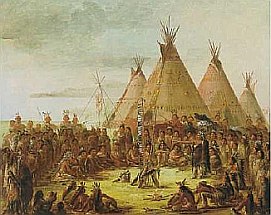
Radius
In classical geometry, a radius of a circle or sphere is any line segment from its center to its perimeter. By extension, the radius of a circle or sphere is the length of any such segment, which is half the diameter. If the object does not have an obvious center, the term may refer to its...
from their bases using a tripod lashing; however, the tipis of the Blackfoot
Blackfoot
The Blackfoot Confederacy or Niitsítapi is the collective name of three First Nations in Alberta and one Native American tribe in Montana....
of Southern Canada
Canada
Canada is a North American country consisting of ten provinces and three territories. Located in the northern part of the continent, it extends from the Atlantic Ocean in the east to the Pacific Ocean in the west, and northward into the Arctic Ocean...
and Northern Montana
Montana
Montana is a state in the Western United States. The western third of Montana contains numerous mountain ranges. Smaller, "island ranges" are found in the central third of the state, for a total of 77 named ranges of the Rocky Mountains. This geographical fact is reflected in the state's name,...
are distinguishable from other plains tribes by the tying of four poles. One end of this lashing
Lashing knot
A lashing is an arrangement of rope used to secure two or more items together in a somewhat rigid manner. Lashings are most commonly applied to timber poles, and are commonly associated with the scouting movement and with sailors....
rope is left dangling from the tie-point, long enough to reach the base of the poles. These tripod
Tripod
A tripod is a portable three-legged frame, used as a platform for supporting the weight and maintaining the stability of some other object. The word comes from the Greek tripous, meaning "three feet". A tripod provides stability against downward forces, horizontal forces and moments about the...
poles are stood upright, with their unfastened ends spaced apart on the ground to form a triangle
Triangle
A triangle is one of the basic shapes of geometry: a polygon with three corners or vertices and three sides or edges which are line segments. A triangle with vertices A, B, and C is denoted ....
, each pole's base the skin's radius from its neighbors. A dozen
Dozen
A dozen is a grouping of approximately twelve. The dozen may be one of the earliest primitive groupings, perhaps because there are approximately a dozen cycles of the moon or months in a cycle of the sun or year...
more long poles are laid onto the three primary poles. Their upper ends rest on the lashing of the first three, and the lower ends are evenly spaced to form a circle
Circle
A circle is a simple shape of Euclidean geometry consisting of those points in a plane that are a given distance from a given point, the centre. The distance between any of the points and the centre is called the radius....
on the ground which includes the original three poles. The lashing rope is then walked around the whole structure three times and pulled tight. This ties the placed poles to the tripod at the crown of the tipi. The canvas skin is tied to another pole, lifted up and the top of the pole is rested where all the poles meet. The skin is pulled around the pole framework. The overlap seam
Stitch (textile arts)
In the textile arts, a stitch is a single turn or loop of thread or yarn. Stitches are the fundamental elements of sewing, knitting, embroidery, crochet, and needle lace-making, whether by hand or machine...
is closed with wooden lacing pins which are thin sticks about 10 inches long with one or both ends tapered. Sometimes a door is attached to one of the bottom lacing pins. In old tipis of hide or early cloth, the door was where the two sides came together in the front. A blanket, hide or cloth door was put over the opening to secure the entrance.
The base of the skin is pegged to the ground. Traditionally pegs were placed in slits at the bottom of the cover. As canvas or cloth came into use loops were sewn into the bottom or, in an emergency smooth pebble
Pebble
A pebble is a clast of rock with a particle size of 4 to 64 millimetres based on the Krumbein phi scale of sedimentology. Pebbles are generally considered to be larger than granules and smaller than cobbles . A rock made predominantly of pebbles is termed a conglomerate...
s were pushed into the cloth and a cord tied between the bulge of cloth and a wooden peg in the ground. A gap can be allowed at ground level for airflow in warm seasons and the base is completely closed to the ground in cooler times. The bases of the non-tripod poles are moved in or out to tension the skin. Inside the tipi, a cord is wrapped from pole to pole above head height. An inner lining can be suspended from this cord and pushed back on the ground near the inside base of the poles. Bedding and personal items are pushed against the liner to keep it in place. The inner lining acts as a heat insulator and draft and pest excluder. An interior awning which prevents rain drops hitting bedding can be suspended at the top of the lining.
Use
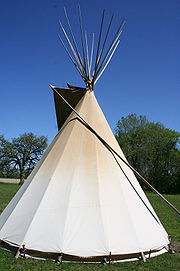
Chimney
A chimney is a structure for venting hot flue gases or smoke from a boiler, stove, furnace or fireplace to the outside atmosphere. Chimneys are typically vertical, or as near as possible to vertical, to ensure that the gases flow smoothly, drawing air into the combustion in what is known as the...
effect and helps carry the smoke up and out. The liner does add insulation in very cold weather when stuffed with grass and can direct the draft upwards and away from the occupants while still admitting fresh air. Air for combustion can be ducted to the fire through a buried pipe when the tipi is closed tightly against inclement weather.
In most weather the lining may not be used, and the cover can be rolled up on very hot days a few feet on one or two sides allowing any small breeze to create ventilation
Ventilation (architecture)
Ventilating is the process of "changing" or replacing air in any space to provide high indoor air quality...
.
This structure requires a hole in the middle of the roof may not be the best shelter in times of intense rain, but there are strategies to reduce the problem. A hide or fabric ceiling can protect against dripping precipitation and reduce drafts. This ceiling, when used, typically only covers the back half of the tipi and is slanted slightly upwards to the front, draining water to the rear and allowing smoke from fire to vent out of the top of the tipi. Small sticks between the lining rope and the poles can create a gap for rainwater running down the poles to reach the ground without being caught by and dripping off the lining rope. Contemporary tipi dwellers may tie a bucket beneath the crown, or install rubber barriers on the poles and a canvas rain catcher which drains from the crown to the outside, to collect rain dripping off the crown of the poles. A fabric or hide rain cap can be placed over the top of the tipi if the poles are not too long but can cause damage in high winds. Historically these types of coverings were not used.
In strong winds the lashing rope is pegged to the ground behind the fire. This helps to keep the tipi poles from “walking”, lifting up under the force of the wind on the skin and coming down in a new position. In extreme winds the bases of the poles can be individually lashed to pegs. A tipi which is pegged and has had its lashing rope tied down is a remarkably wind-resistant cone.
See also
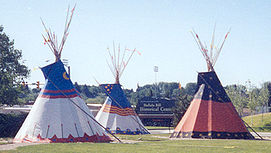
- Chum (tent)Chum (tent)A chum is a temporary dwelling used by the nomadic Yamal-Nenets and Khanty reindeer herders of northwestern Siberia of Russia. They are also used by the southernmost reindeer herders, of the Todzha region of the Republic of Tyva and their cross-border relatives in northern Mongolia...
- GoahtiGoahtiA goahti is a Sami construction that can be similar to a Sami lavvu or a peat covered version using the same base structure. It is often constructed slightly larger than a lavvu...
- HoganHoganA hogan is the primary traditional home of the Navajo people. Other traditional structures include the summer shelter, the underground home, and the sweat house...
- HumpyHumpyA humpy is a small, temporary shelter made from bark and tree branches, traditionally used by Australian Aborigines, with a standing tree usually used as the main support...
- IglooIglooAn igloo or snowhouse is a type of shelter built of snow, originally built by the Inuit....
- KohteKohteThe Kohte is the typical tent of German Scouting and the German Youth Movement. It was developed about 1930 by Eberhard Koebel as a variation of the Sami lavvu and became very quickly popular within the Bündische Jugend...
- LavvuLavvuLavvu is a temporary dwelling used by the Sami people of northern Scandinavia. It has a design similar to a Native American tipi but is less vertical and more stable in high winds. It enables the indigenous cultures of the treeless plains of northern Scandinavia and the high arctic of Eurasia to...
- List of human habitation forms
- Longhouse
- Plains hide paintingPlains hide paintingPlains hide painting is a traditional Plains Indian artistic practice of painting on either tanned or raw animal hides. Tipis, tipi liners, shields, parfleches, robes, clothing, drums, and winter counts could all be painted.-Genres:...
- Sibley tentSibley tentThe Sibley tent was invented by the American military officer Henry Hopkins Sibley and patented in 1856. Of conical design, it stands about twelve feet high and eighteen feet in diameter. It can comfortably house about a dozen men....
- WigwamWigwamA wigwam or wickiup is a domed room dwelling used by certain Native American tribes. The term wickiup is generally used to label these kinds of dwellings in American Southwest and West. Wigwam is usually applied to these structures in the American Northeast...
- Wigwam MotelWigwam MotelThe Wigwam Motels, also known as the "Wigwam Villages", is a motel chain in the United States in which the rooms are built in the form of teepees, hence the name "wigwam". It originally had seven different locations: two locations in Kentucky, a location in Alabama, another location in Florida, one...
- YarangaYarangaA Yaranga is a tent-like traditional mobile home of some nomadic Northern indigenous peoples of Russia, such as Chukchi and Siberian Yupik.A Yaranga is a cone-shaped or rounded reindeer-hide tent. It is built of a light wooden frame covered with reindeer skins or canvas sewn together.The word...
- YurtYurtA yurt is a portable, bent wood-framed dwelling structure traditionally used by Turkic nomads in the steppes of Central Asia. The structure comprises a crown or compression wheel usually steam bent, supported by roof ribs which are bent down at the end where they meet the lattice wall...
- Lone TeepeeLone TeepeeThe Lone Teepee was a landmark along the Seventh Cavalry's march to the Battle of the Little Big Horn. It was where the Indian encampment had been during the Battle of the Rosebud on June 17...
, a historic place in MontanaMontanaMontana is a state in the Western United States. The western third of Montana contains numerous mountain ranges. Smaller, "island ranges" are found in the central third of the state, for a total of 77 named ranges of the Rocky Mountains. This geographical fact is reflected in the state's name,...
, US - List of house types
External links
- History, construction, and evolution of tipis plus Photos and drawings
- Simply Differently.org: Tipi, tipi building resource, how-to manuals and online calculator for canvas lanes
- Tipi Instructions, a PDF document detailing the construction of a tipi.

